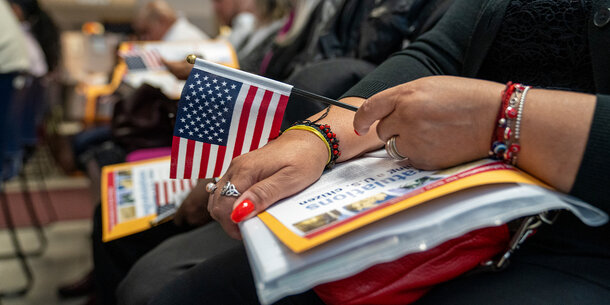President Trump has broadened what started as a “Muslim ban” to block immigration from six more countries. The January 31 executive order added Nigeria, Myanmar, Eritrea, Kyrgyzstan, Sudan, and Tanzania to his personal blocked list.
More than half a billion people — and a quarter of Africa’s population — are now barred from seeking permanent residency in the United States because of the president’s prejudice, whether against Muslims or people from what he has referred to as “shithole countries.”
These bans selectively shut off immigration from countries Trump doesn’t like, and in the process prevent Americans from bringing their spouses and children to come live with them in the United States. They’re in direct conflict with the main purposes of American immigration law, which Congress passed the existing framework for in 1965.
To reassert its authority, Congress needs to pass the No Ban Act, which would repeal the restrictions and make it harder for the president to take similar biased actions in the future.
The truth behind the ban
No amount of regulatory subterfuge can disguise the ban’s clear purpose. As the Brennan Center has argued in our lawsuit challenging the travel ban, the president has a well-documented history of spewing hatred against Muslims, without which the ban would not have existed in the first place.
That a number of countries added recently aren’t predominantly Muslim doesn’t change the fact that bias is the basis for the policy. Indeed, one of the driving forces behind the ban is senior Trump adviser Stephen Miller, an apparent white supremacist whose leaked emails suggest that he sees demographic changes brought upon by nonwhite immigration as an attack on America.
The policy isn’t tailored to achieve its stated goals, also belying its true objective. The reason now given for the ban is essentially that the United States cannot properly identify and screen people from countries that do not take certain actions, like issuing electronic passports, sharing information about criminals and suspected terrorists, or regularly reporting lost or stolen travel documents.
If such issues actually gave rise to a genuine and pressing national security concern, the ban doesn’t target many would-be threats. You’d expect well over a hundred countries to be on the list, since many don’t appear to meet its baseline standards.
And the policy only targets potential immigrants, not those traveling to the United States for temporary visits, even though both categories of people would be traveling on the same deficient passports and be compared against the same incomplete criminal and terrorism databases, presenting the same screening challenges. The administration says this distinction is because it’s harder to deport someone if they’ve come in as an immigrant and are later found to pose a threat — and so the costs of a vetting failure are higher — but it’s also true that the front-end screening for permanent visas is much more rigorous.
The ban also captures far more people than is necessary on its own terms. As former national security officials of both parties pointed out in court filings opposing the last ban, existing law already demands that people who can’t prove who they are don’t get visas. Moreover, as the Cato Institute’s research has shown, screening failures have been extremely rare — 1 in 379 million people that got permission to enter the country between 2002 and 2016 were deadly terrorists.
These actions emerge in the context of an administration that’s made every effort to stop people from legally becoming Americans, from means-testing permanent residency applications to erecting procedural and evidentiary hurdles that make it harder to get a visa. Trump even explored how to get rid of birthright citizenship, which became guaranteed by the 14th Amendment after the Civil War. In this light especially, a blanket ban on more than half a billion people from places the president regularly disparages seems better explained as a measure to keep out new Americans, not one to improve national security.
The president is overreaching
A system in which the president can indefinitely ban immigrants from wherever he disfavors isn’t consistent with the separation of powers. The Constitution clearly gives Congress the power to make the rules that determine who can come to America and become a citizen, and legislators did exactly that by passing the Immigration and Nationality Act (INA) of 1965, the law that still largely governs U.S. immigration policy.
As he signed the bill beneath the Statue of Liberty, President Lyndon Johnson emphasized how it would end “the harsh injustice of … national origins quota[s],” which favored white Europeans, and instead prioritize the reunification of families. He added that it was un-American that “families were kept apart because a husband or a wife or a child had been born in the wrong place.”
Indeed, prominent Trump administration officials in charge of immigration policy have said that the 1965 law was a mistake and that they would return to what was before it. It shouldn’t surprise anyone, then, that Trump’s immigration bans reflect those preferences: they explicitly favor certain nationalities over others and keep separate families that would otherwise be united.
The immigration bans directly contradict what Congress has prescribed. And while it’s true that the drafters of the 1965 law may not have foreseen its demographic impacts, these are questions squarely within Congress’ mandate to address.
Calling something a “national security” matter isn’t a license to discriminate, nor is it an excuse to jettison existing laws on the books. The No Ban Act would reverse Trump’s orders and amend the INA provision he has leaned on for the Muslim ban and its expansion, making it harder for any president to enact prejudiced policies in the future. Among other things, the bill would strengthen the INA’s anti-discrimination language. It would also require that decisions to ban people from the United States be supported by evidence, of a defined duration, and closely tailored to the purpose they are intended to achieve.
The administration’s claims of national security do not exist in a vacuum. They exist in a world where Trump said that people from Nigeria would “never go back to their huts” after coming to the United States. Combine this with the president’s absence of authority or a rational basis for how countries are added to the ban list and, and the reality is undeniable. Trump’s travel ban is illegal, and it is racist.



